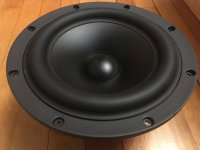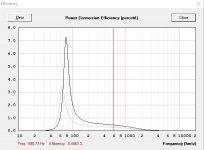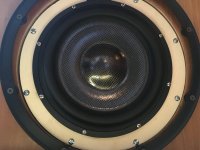I have found that low Intermodulation Distortion is a good indicator of sound quality. The last couple of years I have been measuring 10-12" subwoofers and 6-7" midwoofers in IMD, I will now share some testing in 8" drivers.
The test enclosure is a .5 cu ft (14 liter) sealed box with the bottom lip of the speaker just 2 inches above the floor. The microphone is on a stand 49"high with the base of the microphone 33" from the driver. A distance of about 1.5m from the speaker to the microphone. As I'm not measuring in an anechoic chamber my measurements are not comparable to anyone else's but comparisons can be made between the drivers I test.
Feel free to make suggestions on what drivers you want to see tested.
The test enclosure is a .5 cu ft (14 liter) sealed box with the bottom lip of the speaker just 2 inches above the floor. The microphone is on a stand 49"high with the base of the microphone 33" from the driver. A distance of about 1.5m from the speaker to the microphone. As I'm not measuring in an anechoic chamber my measurements are not comparable to anyone else's but comparisons can be made between the drivers I test.
Feel free to make suggestions on what drivers you want to see tested.
First up is the Dayton RS 225-8 and Dayton RSS 210HF-4. The Dayton RS 225-8 is very well designed and it's high frequency breakup is not as bad as you would expect from an aluminum cone, The Dayton RSS 210HF-4 is running super clean in the 60 and 144 hz IMD test.

Text above edited from it's as bad as you would expect to read is not as bad as you would expect

Text above edited from it's as bad as you would expect to read is not as bad as you would expect
Attachments
-
 3IMD150RS&RSS70db.jpg170 KB · Views: 216
3IMD150RS&RSS70db.jpg170 KB · Views: 216 -
 3IMD150RS&RSS80db.jpg178.3 KB · Views: 191
3IMD150RS&RSS80db.jpg178.3 KB · Views: 191 -
 3IMD150RS&RSS90db.jpg167.5 KB · Views: 168
3IMD150RS&RSS90db.jpg167.5 KB · Views: 168 -
 3IMD300RS&RSS80db.jpg155.1 KB · Views: 168
3IMD300RS&RSS80db.jpg155.1 KB · Views: 168 -
 3IMD300RS&RSS90db.jpg171.2 KB · Views: 160
3IMD300RS&RSS90db.jpg171.2 KB · Views: 160 -
 3IMD800RS&RSS70db.jpg166.5 KB · Views: 159
3IMD800RS&RSS70db.jpg166.5 KB · Views: 159 -
 RS&RSS40IMD70db.jpg183.6 KB · Views: 138
RS&RSS40IMD70db.jpg183.6 KB · Views: 138 -
 3IMD800RS&RSS80db.jpg159 KB · Views: 135
3IMD800RS&RSS80db.jpg159 KB · Views: 135 -
 RS&RSS40IMD80db.jpg179.6 KB · Views: 123
RS&RSS40IMD80db.jpg179.6 KB · Views: 123 -
 RS&RSS40IMD85db.jpg188.5 KB · Views: 128
RS&RSS40IMD85db.jpg188.5 KB · Views: 128 -
 RS&RSS50IMD70db.jpg176.9 KB · Views: 104
RS&RSS50IMD70db.jpg176.9 KB · Views: 104 -
 RS&RSS50IMD80db.jpg172.2 KB · Views: 97
RS&RSS50IMD80db.jpg172.2 KB · Views: 97 -
 RS&RSS60IMD80db.jpg175.2 KB · Views: 95
RS&RSS60IMD80db.jpg175.2 KB · Views: 95 -
 RS&RSS75IMD80db.jpg169.8 KB · Views: 93
RS&RSS75IMD80db.jpg169.8 KB · Views: 93 -
 RS&RSS60IMD90db.jpg180.8 KB · Views: 87
RS&RSS60IMD90db.jpg180.8 KB · Views: 87 -
 RS&RSS75IMD90db.jpg167.5 KB · Views: 186
RS&RSS75IMD90db.jpg167.5 KB · Views: 186
Last edited by a moderator:
Next up is the SB Acoustics SB23MFCL45-4 and Dayton RSS 210HO-4. The SB acoustics does really well in my application. That is a small subwoofer that can handle a high crossover point of 100hz to blend with a 4" omni full range. Many subwoofers started to sound strained above 80hz (try listening to your sub only playing music and turn the low pass dial past 100hz and you'll hear it) but not the SB, it has a lighter weight voice coil so that it can play better into the midrange area but it also has a 32mm voice coil height that helps it do well in deep bass.
The Dayton RSS 210HO-4 has a few more mm xmax than the RSS 210HF and this can be seen put to work in a cleaner 40 and 96 IMD test for the HO.
The Dayton RSS 210HO-4 has a few more mm xmax than the RSS 210HF and this can be seen put to work in a cleaner 40 and 96 IMD test for the HO.
Attachments
-
 3IMD150D&S70db.jpg180.4 KB · Views: 165
3IMD150D&S70db.jpg180.4 KB · Views: 165 -
 3IMD150D&S80db.jpg178.2 KB · Views: 139
3IMD150D&S80db.jpg178.2 KB · Views: 139 -
 3IMD150D&S90db.jpg175.2 KB · Views: 125
3IMD150D&S90db.jpg175.2 KB · Views: 125 -
 8D&S40IMD70db.jpg179.7 KB · Views: 127
8D&S40IMD70db.jpg179.7 KB · Views: 127 -
 8D&S40IMD80db.jpg176.4 KB · Views: 127
8D&S40IMD80db.jpg176.4 KB · Views: 127 -
 8D&S40IMD85db.jpg188.7 KB · Views: 121
8D&S40IMD85db.jpg188.7 KB · Views: 121 -
 8D&S60IMD80db.jpg174.6 KB · Views: 118
8D&S60IMD80db.jpg174.6 KB · Views: 118 -
 8D&S60IMD90db.jpg178.5 KB · Views: 112
8D&S60IMD90db.jpg178.5 KB · Views: 112 -
 8D&S75IMD80db.jpg175.5 KB · Views: 114
8D&S75IMD80db.jpg175.5 KB · Views: 114 -
 8D&S75IMD90db.jpg185.5 KB · Views: 135
8D&S75IMD90db.jpg185.5 KB · Views: 135 -
 SB.JPG320.5 KB · Views: 184
SB.JPG320.5 KB · Views: 184
Thanks for taking the time to do all these tests!
Testing many drivers under a common methodology by the same person is rare, as is IMD testing. This is great content and deserves more attention than it gets. It's understandable that it doesn't, being fairly specialized and requiring decent foundational knowledge to make use of. Nevertheless, know that it's appreciated, and will be referenced often.
Testing many drivers under a common methodology by the same person is rare, as is IMD testing. This is great content and deserves more attention than it gets. It's understandable that it doesn't, being fairly specialized and requiring decent foundational knowledge to make use of. Nevertheless, know that it's appreciated, and will be referenced often.

For those following the thread the text in post #2 has been edited.
The Dayton RS 225-8 is very well designed and it's high frequency breakup it's as bad as you would expect from an aluminum cone now
Now reads as:
The Dayton RS 225-8 is very well designed and it's high frequency breakup is not as bad as you would expect from an aluminum cone
Since I level match all tones 32 would be too difficult but I could do 5. I probably won't get around to retesting any drivers though. What 5 tones can you suggest? They shouldn't share harmonics as I understand.+1.
I wonder if you have the capacity to do 5 tone testing. Or 32 tone testing?
Next up for testing is this Purifi PTT8.0X04-NAB-02. I have given the Purifi a challenging test by comparing the IMD graphs in the bass frequencies with a Seas 10" subwoofer and with a 8" Dayton RS woofer in the midrange frequencies. Please note that the drivers are displayed in alphabetical order. The Purifi is a special driver it can belt out clean deep bass but at the same time it is nimble enough to reproduce the gran cassa or the string bass.
Attachments
-
 3IMD150RS&P70db.jpg.png422.5 KB · Views: 168
3IMD150RS&P70db.jpg.png422.5 KB · Views: 168 -
 3IMD150RS&P90db.jpg170.6 KB · Views: 140
3IMD150RS&P90db.jpg170.6 KB · Views: 140 -
 3IMD150RS&P80db.jpg171.8 KB · Views: 145
3IMD150RS&P80db.jpg171.8 KB · Views: 145 -
 3IMD300RS&P80db.jpg157.7 KB · Views: 141
3IMD300RS&P80db.jpg157.7 KB · Views: 141 -
 3IMD300RS&P90db.jpg169.8 KB · Views: 141
3IMD300RS&P90db.jpg169.8 KB · Views: 141 -
 3IMD800RS&P70db.jpg169.6 KB · Views: 133
3IMD800RS&P70db.jpg169.6 KB · Views: 133 -
 3IMD800RS&P80db.jpg150.6 KB · Views: 135
3IMD800RS&P80db.jpg150.6 KB · Views: 135 -
 40and96hz70dbPvsROY.jpg180.1 KB · Views: 123
40and96hz70dbPvsROY.jpg180.1 KB · Views: 123 -
 40and96hz85dbPurvsSeas.jpg186.5 KB · Views: 117
40and96hz85dbPurvsSeas.jpg186.5 KB · Views: 117 -
 40and96hz80dbPurvsSeas.jpg179.7 KB · Views: 119
40and96hz80dbPurvsSeas.jpg179.7 KB · Views: 119 -
 40and96hzexp.jpg195 KB · Views: 116
40and96hzexp.jpg195 KB · Views: 116 -
 60and144hz80dbPvsROY.jpg172.7 KB · Views: 113
60and144hz80dbPvsROY.jpg172.7 KB · Views: 113 -
 60and144hz90dbPvsROY.jpg179.3 KB · Views: 116
60and144hz90dbPvsROY.jpg179.3 KB · Views: 116 -
 75and180hz80dbPvsROY.jpg162.7 KB · Views: 105
75and180hz80dbPvsROY.jpg162.7 KB · Views: 105 -
 75and180hz90dbPvsROY.jpg162.3 KB · Views: 137
75and180hz90dbPvsROY.jpg162.3 KB · Views: 137 -
 IMG_4710.JPG352 KB · Views: 174
IMG_4710.JPG352 KB · Views: 174
Next up in IMD testing is the Morel TSCW 938. The midbass through lower midrange is very detailed with this driver. Drums, bass guitar and string bass all sound very real. I've compared the Morel data with the Dayton RS 225-8. I've also plotted the modeled efficiency of the Morel in black with the Purifi PTT8.0X04-NAB-02 in grey both in 14 liters sealed. So far my experience has been that woofers sound best in the region of higher efficiency that is just below to just above the impedence peak.
Attachments
-
 3IMD150D&M70db.jpg170.4 KB · Views: 113
3IMD150D&M70db.jpg170.4 KB · Views: 113 -
 3IMD150D&M80db.jpg170.8 KB · Views: 92
3IMD150D&M80db.jpg170.8 KB · Views: 92 -
 3IMD150RD&M90db.jpg168.7 KB · Views: 91
3IMD150RD&M90db.jpg168.7 KB · Views: 91 -
 3IMD300D&M80db.jpg157.6 KB · Views: 93
3IMD300D&M80db.jpg157.6 KB · Views: 93 -
 3IMD300D&M90db.jpg177.6 KB · Views: 92
3IMD300D&M90db.jpg177.6 KB · Views: 92 -
 D&M40IMD70db.jpg178.8 KB · Views: 83
D&M40IMD70db.jpg178.8 KB · Views: 83 -
 D&M40IMD85db.jpg191.6 KB · Views: 89
D&M40IMD85db.jpg191.6 KB · Views: 89 -
 D&M40IMD80db.jpg180.4 KB · Views: 87
D&M40IMD80db.jpg180.4 KB · Views: 87 -
 D&M60IMD80db.jpg186.3 KB · Views: 88
D&M60IMD80db.jpg186.3 KB · Views: 88 -
 D&M60IMD90db.jpg180.3 KB · Views: 88
D&M60IMD90db.jpg180.3 KB · Views: 88 -
 D&M75IMD80db.jpg167.4 KB · Views: 95
D&M75IMD80db.jpg167.4 KB · Views: 95 -
 D&M75IMD90db.jpg169.1 KB · Views: 89
D&M75IMD90db.jpg169.1 KB · Views: 89 -
 Efficiency.jpg40.3 KB · Views: 108
Efficiency.jpg40.3 KB · Views: 108 -
 IMG_4819.JPG420.2 KB · Views: 114
IMG_4819.JPG420.2 KB · Views: 114
All,
Once, on the Purifi website (I think) there was a set of audio WAV files where you could hear a computer audio simulation of two kinds of distortion: changes in BL and inductance based on excursion, and changes in KMS based on suspension compliance based on excursion. The result was a very clear demo of intermodulation distortion, it was clearly audible. But I can't seem to find those anymore. Anyone know where those are? @shrub0
Perry
Once, on the Purifi website (I think) there was a set of audio WAV files where you could hear a computer audio simulation of two kinds of distortion: changes in BL and inductance based on excursion, and changes in KMS based on suspension compliance based on excursion. The result was a very clear demo of intermodulation distortion, it was clearly audible. But I can't seem to find those anymore. Anyone know where those are? @shrub0
Perry
Last edited:
Member
Joined 2003
Yes 14 liters. In a cabinet to present a use case, I don’t think anyone would blast 40hz from a single 8” in a dipole.
Each frequency is level matched for example I adjust the input level on the 40 and 96hz tones until they are both 80db or whatever db I’m going for in the test.
I was worried about mic overloading so I test at 1.5m yes I know this allows the room to change the results but every driver sees the same testing conditions.
Each frequency is level matched for example I adjust the input level on the 40 and 96hz tones until they are both 80db or whatever db I’m going for in the test.
I was worried about mic overloading so I test at 1.5m yes I know this allows the room to change the results but every driver sees the same testing conditions.
Last edited:
It's not about the use case of a dipole, it's about minimizing variables.Yes 14 liters. In a cabinet to present a use case, I don’t think anyone would blast 40hz from a single 8” in a dipole.
Each frequency is level matched for example I adjust the input level on the 40 and 96hz tones until they are both 80db or whatever db I’m going for in the test.
If those tests were done without a compensated frequency response, it brings it close to invalid.
Even if you match the levels, the response is just totally different.
Especially inside a cabinet, (some) speakers can interact with it very differently.
There will also be resonances, reflections and other things inside the cabinet (which are not equal in all different tests).
At 1.5m it could be difficult to see the difference between reflections and actual sound.
But we can only guess at this point.
Comparisons like this are always super hard to do.
With the danger of drawing the wrong conclusions from it.
Thanks for your feedback b_force I believe there are also pros and cons to testing on a free air baffle.
such as:
Pros: less interaction from the enclosure
Cons: noise from the pole vent or other venting system will be more prevalent.
Heavier cone drivers may cause the baffle or whatever mounting system you are using to resonate more.
To me my tests have a good correlation of what sounds clean in listening tests to those with low IMD. It is in no means a perfect test. There are many variables. For example, many drivers have lower IMD at the in box impedance peak, this is why I choose a variety of tests at different frequencies, there could be more tests done, but for a hobbyist working in my spare time I think my tests have some value to them. Also this goes back to the use cause as now the box impedance peak is in a range with more music content usually 50-60 hz compared to the free air resonance of 20-30 hz.
I have found very few other level matched IMD tests results on the web, which to me is the preferred way to do it. As far as I know Hifi Compass and Joseph Crowe do not level match. b_force you have tried to critique my IMD tests elsewhere on this forum. Have you any data to share yourself?
such as:
Pros: less interaction from the enclosure
Cons: noise from the pole vent or other venting system will be more prevalent.
Heavier cone drivers may cause the baffle or whatever mounting system you are using to resonate more.
To me my tests have a good correlation of what sounds clean in listening tests to those with low IMD. It is in no means a perfect test. There are many variables. For example, many drivers have lower IMD at the in box impedance peak, this is why I choose a variety of tests at different frequencies, there could be more tests done, but for a hobbyist working in my spare time I think my tests have some value to them. Also this goes back to the use cause as now the box impedance peak is in a range with more music content usually 50-60 hz compared to the free air resonance of 20-30 hz.
I have found very few other level matched IMD tests results on the web, which to me is the preferred way to do it. As far as I know Hifi Compass and Joseph Crowe do not level match. b_force you have tried to critique my IMD tests elsewhere on this forum. Have you any data to share yourself?
I absolutely don't understand this sentence?Have you any data to share yourself?
The goal is to make a fair and objective comparison, so people don't draw the wrong or (unintentionally) biased conclusions?
Which means it has to be clear what the ins- and outs are of a certain measuring method.
You can already figure out how valid a certain test method is, by thinking about possible problems within a test.
(thought experiments).
Someone doesn't have come up with "other data or results" to "prove" that a certain testing method is valid or invalid.
That is not how feedback goes.
Well I was just curious if you have any IMD data to share. It seems you have a preferred way to do the tests.
You have already critiqued my testing here: https://www.diyaudio.com/community/threads/new-aluminum-cone-purifi-drivers.382663/page-5 and as I welcome feedback I there asked questions such as how to make my spreadsheet more legible and what drivers you would like to see tested but you didn't provide feedback except the price category, which I will try to include.
You have already critiqued my testing here: https://www.diyaudio.com/community/threads/new-aluminum-cone-purifi-drivers.382663/page-5 and as I welcome feedback I there asked questions such as how to make my spreadsheet more legible and what drivers you would like to see tested but you didn't provide feedback except the price category, which I will try to include.
- Home
- Loudspeakers
- Multi-Way
- 8" Woofer/Subwoofer Intermodulation Distortion Testing